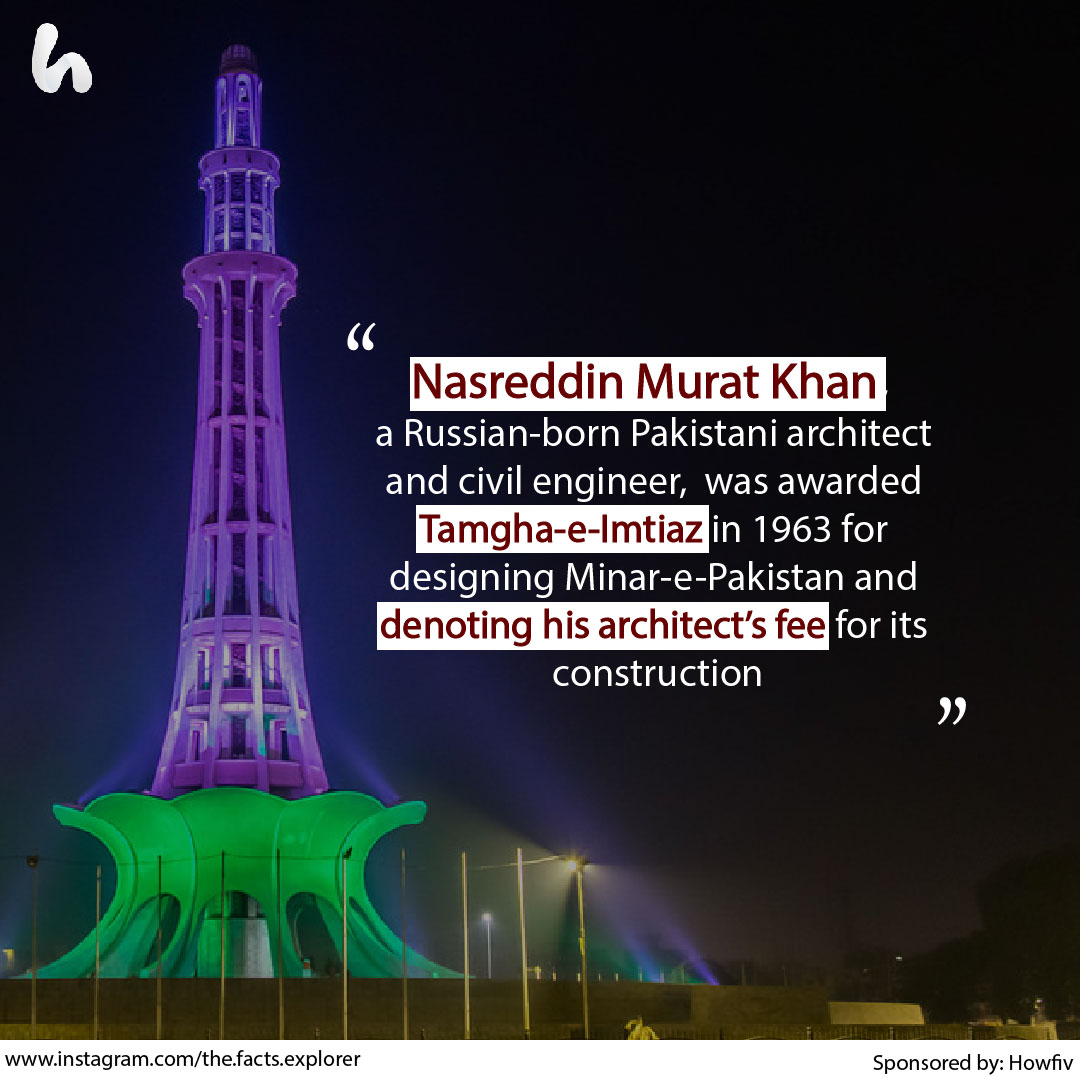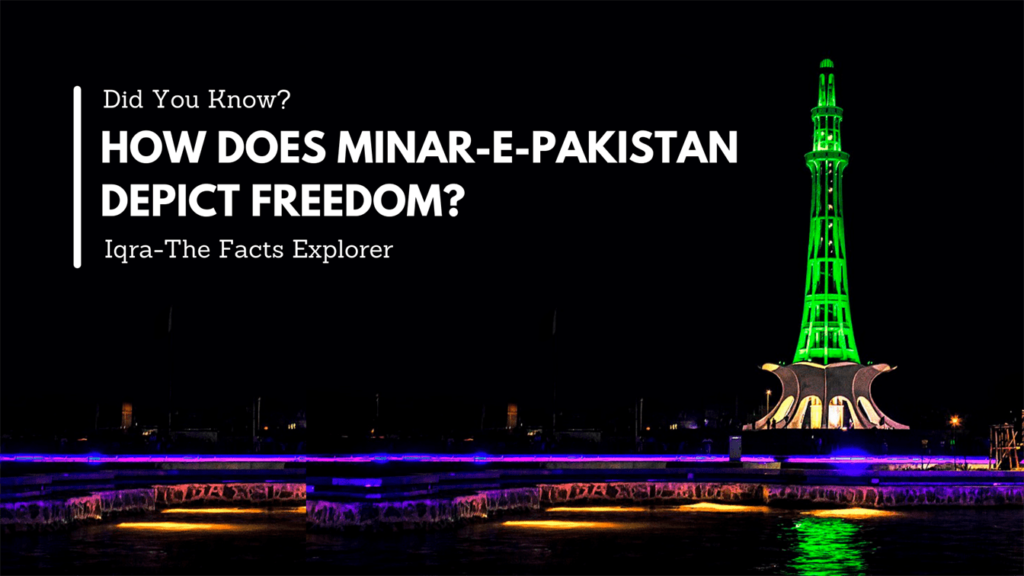Minar-e-Pakistan is the most publicized tower of Pakistan. Like every national monument, it tells the tale of the struggles and sacrifices made by our founding fathers for the establishment of Pakistan. The following facts about Minar-e-Pakistan would revitalize the spirit of every Pakistani.
Minar-e-Pakistan, the national tower of Pakistan, is the tallest minaret located in Iqbal Park near Badshahi Mosque Lahore. About seventy meters in height from the ground level, the tower is rich in the symbols standing for the history of Pakistan. However, the base of the tower is elevated to eight meters on which the Minar-e-Pakistan stands firm and tall, symbolic of the line of eternal progress. Therefore, its generally known height is about sixty-two meters- eliminating the lower eight meters. Another commemorating fact of the minaret is that it is built on the base platform of a five-pointed star with a crescent-shaped pool surrounding it, which clearly depicts its importance in the establishment of Pakistan. The story of the Monument’s construction is the allegory of the making of the land of pure, Pakistan.

Established in October 1969, Minar-e-Pakistan, in fact, marks the Lahore Resolution passed on March 23, 1940, by the Muslim League at Minto Park, Lahore, which led to the creation of Pakistan. Nasreddin Murat Khan, a Russian-born Pakistani architect and civil engineer, is the mastermind behind the incomparable design of the national tower who volunteered for the project after the multiple failed provided designs. Such has been his devotion to the nation that he gifted the ever-existing design, without an architect’s fee, to its homeland. For the sake of knowledge, Nasreddin is the same architect who designed Nishtar Medical College, Mansehra Mental Hospital, Fortress Stadium, Qaddafi Stadium, the Textile College, and various Water and Power Development Authority (WAPDA) flats and housing colonies all over Pakistan. A document from his desk elaborating the design concept behind the monument of ideology is as follows:
There might be an objection that the appearance of the memorial is not traditional, contrary to the spirit of Islam and so on. To keep to tradition does not mean to imitate old forms without thinking of the ideas underlying them i.e., to use the elements of tradition in a manner suited to the occasion. It would, for instance, be very unfortunate to give this memorial the traditional shape of a tomb since it most certainly is a moment of life. Or could it, for obvious reasons be given the shape of a palace, and anybody would disagree that a mosque only should look like a mosque. Pakistan is a bold and new experiment in the world of Islam. Let then be adorned with the tranquil beauty of Moghul ornamentation, the memorial be a bold and a new one.
Nonetheless, the top point of the initial design, which was there to signify the never-ending glory of the country, has been transformed to a dome by the committee to bring it closer to Islamic architecture.
The construction of the tower began in 1960 under the rule of Ayub Khan- the then president of Pakistan and was completed in eight years at a total cost of Rs. 7.5 million, the significant amount of which was raised by the levy of additional taxes on cinema and horse racing. During the construction of the Minar-e-Pakistan, Nasreddin Murat Khan used to visit the construction site on regular basis to keep a sharp eye at the pace of work. For his contribution to architecture in Pakistan, Murat Khan was awarded Tamgha-e-Imtiaz in 1963, the highest civilian award in Pakistan. Other nominal contributors of the project of Minar-e-Pakistan were Usman Khan, the engineer; Abdur Rehman Khan Niazi, the structural engineer; Mian Abdul Khaliq, the contractor; Akhtar Hussain, then governor of West Pakistan, and Mr. Mukhtar Masood, then deputy commissioner of Lahore.
Moving further to the symbolic significance of Minar-e-Pakistan, the way leading to the tower comprises of four steps: first, uncut Taxila stones step; Second, forged stones step; third, carved stones step; and fourth, white marble step. The diversity in the steps from raw stones to the well-polished marble signifies the transition from the difficult developments of Pakistan to its final success for independence.
On the base, the blossoming flower structure with ten marble petals contains the text of Lahore Resolution and the text of the Delhi Resolution- both having significant value in the creation of separate homelands for Muslims. Additionally, the Quranic verses, ninety-nine names of Allah, and the national anthem of Pakistan have also been engraved on its walls. Excerpts from the speeches of the great leader, Mohammad Ali Jinnah and a few couplets of the prolific poet, Allama Iqbal are also inscribed.
Initially, Minar-e-Pakistan, with panoramic views of the city, has remained open for the visitors. People who could not climb stairs could use an elevator to reach the top of the building. But now, due to certain circumstances, the Parks and Horticultural Authority (PHA) has restricted the people from going near Minar-e-Pakistan, and a grill has also been placed around to stop people from going near it. According to PHA notification, it would again be open to the public soon once the concerns are fulfilled.
Hence, Minar-e-Pakistan is not merely a tower; it is the manifesto of all the struggles and sacrifices of our forefathers for the establishment of Pakistan. However, the worsening air pollution and numerous unorganized rallies have damaged the national memory. Although in 2014, the Punjab government has banned all political or non-political large gatherings, the monument still needs considerable refurbishment.
Want to read CSS Pakistan Affairs Solved Past Papers and learn how to attempt them to score high? Let’s click on the link below to read them all freely. All past papers’ questions have been attempted by Sir Kazim’s students, who scored the highest in the subject.
CSS Solved Pakistan Affairs

More Essays
Click on any to start reading the essay.
Want to read General Science & Ability Solved Past Papers to learn how to attempt them to score high? Let’s click on the link below to read them all freely. All past papers have been solved by Miss Iqra Ali & Dr Nishat Baloch, Pakistan’s top CSS GSA coach having the highest score of their students.
Articles Might Interest You!
The following are some of the most important articles for CSS and PMS aspirants. Click on any to start reading.












